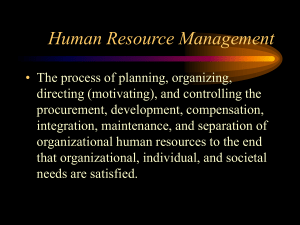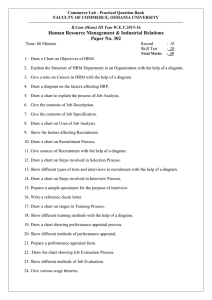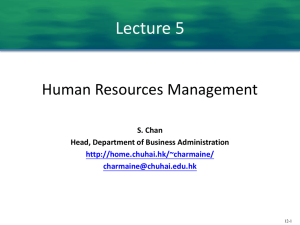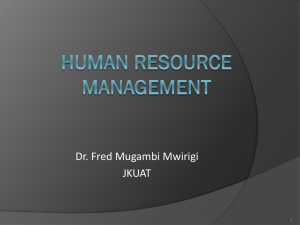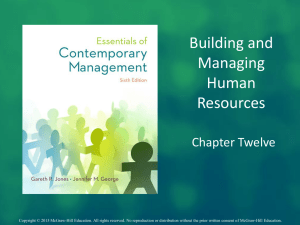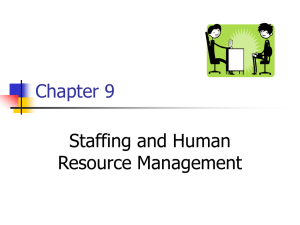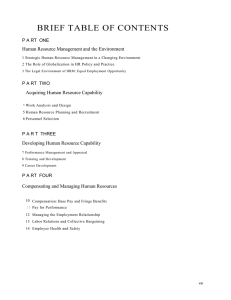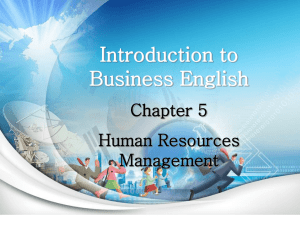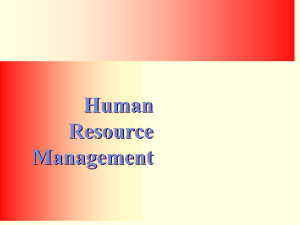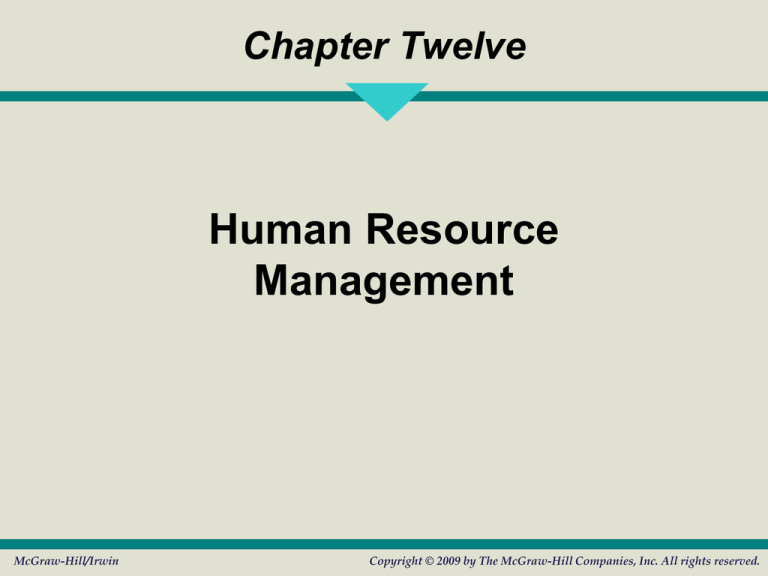
Chapter Twelve
Human Resource
Management
McGraw-Hill/Irwin
Copyright © 2009 by The McGraw-Hill Companies, Inc. All rights reserved.
Strategic Human Resource Management
Human Resource Management (HRM)
≈ Activities that managers engage in to attract
and retain employees and to ensure that they
perform at a high level and contribute to the
accomplishment of organizational goals.
MNGT 341, MNGT 408, MNGT 441
12-2
12-3
12-4
12-5
12-6
12-7
Strategic Human Resource Management
Strategic Human Resource
Management
≈ The process by which managers design the
components of a HRM system to be consistent
with each other, with other elements of
organizational architecture, and with the
organization’s strategy and goals.
12-8
Components of a Human Resource
Management System
Figure 12.1
12-9
“We think of work as fun, and by
that we mean thoroughly engaging,
challenging, rewarding, and
enjoyable.”
12-10
The Legal Environment of HRM
Equal Employment Opportunity (EEO)
≈ The equal right of all citizens to the opportunity
to obtain employment regardless of their
gender, age, race, country of origin, religion,
or disabilities.
≈ Equal Employment Opportunity Commission
(EEOC) enforces employment laws.
12-11
The Legal Environment of HRM
National Labor Relations Act (1935)
≈ Right to unionize, bargain, and strike
Fair Labor Standards Act (1938)
≈ Minimum wage, overtime
Equal Pay Act of 1963
Civil Rights Act of 1964
≈ Disparate treatment and adverse impact (note recent S.Ct.
decision involving New Haven, CT firefighters)
Age Discrimination in Employment Act
Occupational Safety and Health Act (1970)
Pregnancy Discrimination Act
Americans with Disabilities Act
Family and Medical Leave Act
12-12
The Legal Environment of HRM
Contemporary challenges for managers
≈ How to eliminate sexual harassment
≈ How to make accommodations for employees
with disabilities
≈ How to deal with employees who have
substance abuse problems
≈ How to manage HIV-positive employees and
employees with AIDs
12-13
Recruitment and Selection
Recruitment
≈ Activities that managers engage in to develop
a pool of candidates for open positions.
Selection
≈ The process that managers use to determine
the relative qualifications of job applicants and
their potential for performing well in a
particular job.
12-14
Human Resource Planning
Human Resource Planning (HRP)
≈ Activities that managers engage in to forecast
their current and future needs for human
resources.
Demand, supply forecast
12-15
Human Resource Planning
Outsourcing
≈ Using outside suppliers and manufacturers to
produce goods and services
≈ Using contract workers rather than hiring
them.
More flexible for the firm.
Provides human capital at a lower cost.
12-16
Job Analysis
Job Analysis
≈ Identifying the tasks, duties and
responsibilities that make up a job and the
knowledge, skills, and abilities needed to
perform the job.
12-17
Recruitment
External Recruiting
≈ Looking outside the organization for people
who have not worked at the firm previously.
Newspapers advertisements, open houses, oncampus recruiting, employee referrals, and through
the Internet.
• Note CareerFest presentation
12-18
Recruitment
Internal Recruiting
≈ Managers turn to existing employees to fill
open positions
≈ Benefits of internal recruiting:
Internal applicants are already familiar with the
organization
Managers already know candidates
Can help boost levels of employee motivation and
morale
12-19
Honesty in Hiring
Realistic Job Preview
≈ Providing an honest assessment of the
advantages and disadvantages of a job and
organization.
Can reduce the number of new hires who quit when
their jobs and organizations fail to meet their
unrealistic expectations
12-20
The Selection Process
Selection process
≈ Managers find out whether each applicant is
qualified for the position and likely to be a
good performer
12-21
Selection Tools
Figure 12.3
12-22
Interviews and Tests
Clarification (pp. 436-37)
≈ Mngrs should not ask questions that are irrelevant to
job in question (may expose Co to legal liability and
may be invalid)
However, employment in U.S. is “at will”
• Er decisions can be based on good reasons, bad reasons, or no
reasons whatsoever provided they are not based on reasons made
illegal by statute (race, gender, religion, etc.)
While gender discrimination is illegal under Civil Rights Act,
questions about spouse’s background or family plans don’t
necessarily involve gender discrimination
• Note state law may go beyond federal law (E.g., in IN Er cannot
discriminate on basis of smoking, Er in MI can do so)
≈ Use of invalid paper-and-pencil test is not grounds for
lawsuit, but if test results in adverse impact then it
must be shown to be valid
12-23
Reliability and Validity
Reliability
≈ the degree to which the tool measures the
same thing each time it is used (consistency)
Validity
≈ the degree to which the test measures what it
is supposed to measure (accuracy)
Note that no test predicts perfectly, so objective
should be to use tests with greatest validity (so as
to maximize correct predictions)
12-24
Training and Development
Training
≈ Teaching organizational members how to
perform current jobs and helping them to
acquire the knowledge and skills they need to
be effective performers.
Development
≈ Building the knowledge and skills of
organizational members to enable them to
take on new responsibilities and challenges.
12-25
Training and Development
Needs Assessment
≈ An assessment of which employees need
training or development and what type of skills
or knowledge they need to acquire.
12-26
Training and Development
Figure 12.4
12-27
Performance Appraisal and Feedback
Performance Appraisal
≈ The evaluation of employees’ job performance
and contributions to their organization.
≈ Traits, behaviors, results
≈ Clarification re: lawsuit against Ford concerning
forced distribution (p. 444) – issue wasn’t simply
that system was unfair, but that it was used in
discriminatory fashion (i.e., age discrimination)
Ford discontinued system
• Hard to validate system based on subjective appraisals
12-28
Subjective Measures of Performance:
Graphic and Behaviorally Anchored Rating Scales
Figure 12.5
12-29
Subjective Measures of Performance:
Behavioral Observation Scale
Figure 12.5
12-30
Who Appraises Performance?
Figure 12.6
12-31
Effective Feedback Tips
Be specific and focus on behaviors or outcomes
that are correctable and within a worker’s ability
to improve.
Approach performance appraisal as an exercise
in problem solving and solution finding, not
criticizing.
Express confidence in a subordinate’s ability to
improve.
Provide performance feedback both formally and
informally.
12-32
Pay and Benefits
Pay
≈ Includes employees’ base salaries, pay raises,
and bonuses
≈ Determined by characteristics of the
organization and the job and levels of
performance
≈ Benefits are based on membership in an
organization (although vacation days often
linked to seniority)
12-33
Pay and Benefits
Pay level
≈ The relative position of an organization’s
incentives in comparison with those of other
firms in the same industry employing similar
kinds of workers
12-34
Pay and Benefits
Pay Structure
≈ The arrangement of jobs into categories based on
their relative importance to the organization and its
goals, level of skills, and other characteristics.
Pay grades and pay ranges
12-35
Pay and Benefits
Benefits
≈ Legally required: social security, workers’
compensation, unemployment insurance (and
FMLA leave)
≈ Voluntary (discretionary): health insurance,
pension plans, vacations and holidays, etc.
≈ Cafeteria-style benefit plans allow employees
to choose the best mix of benefits for them;
can be hard to manage.
12-36
Labor Relations
Labor Relations
≈ The activities managers engage in to ensure
they have effective working relationships with
the labor unions that represent their
employees’ interests.
12-37
Unions
Unions
≈ Represent worker’s interests to management
in organizations.
≈ The power that a manager has over an
individual worker causes workers to join
together in unions to try to restrict this.
≈ Correction (p. 451): several unions
(constituting ~1/3 of membership) withdrew
from AFL-CIO in 2005 to form the Change-toWin coalition
12-38
Unions
Collective bargaining
≈ Negotiation between labor and management
to resolve conflicts and disputes about issues
such as working hours, wages, benefits,
working conditions, and job security.
12-39

